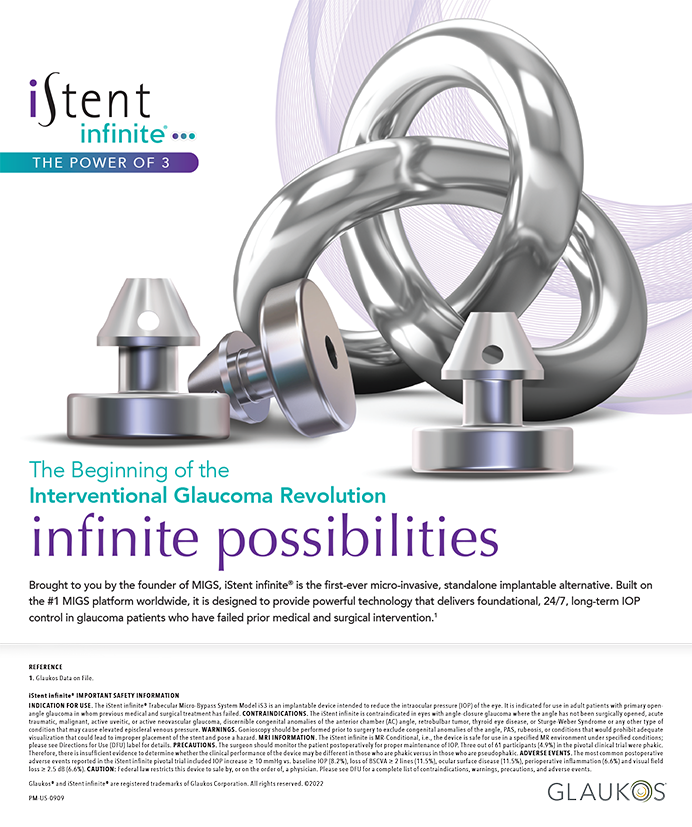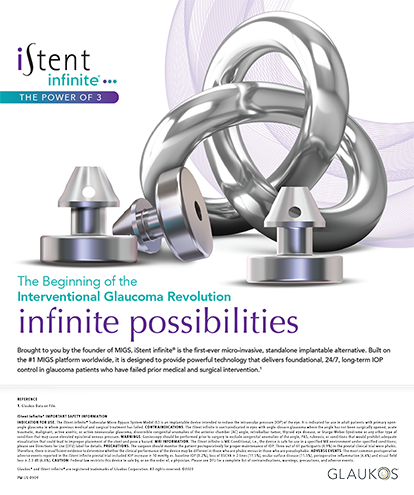
Patients with keratoconus typically present with vision loss. Their visual dysfunction often becomes apparent in adolescence or early adulthood. Because of the progressive nature of the disease and their frustration with poor vision despite wearing spectacles or soft contact lenses, most patients feel anxious about their prognosis.
Thanks to the widespread availability of CXL and specialty contact lenses, ophthalmologists can guide most individuals with keratoconus along a journey that takes them from disease progression and worsening vision to disease stability and excellent vision. I have been in practice long enough to remember a time when the options for these patients were limited to behavioral modification, a small number of contact lenses, intrastromal corneal ring segments, and keratoplasty. Keratoplasty has a high success rate, but many patients develop postoperative sequelae such as ocular surface disease, secondary glaucoma, graft rejection and failure, infectious keratitis, and a ruptured globe from corneal trauma. Avoiding keratoplasty improves patient outcomes and helps to ensure long-term success.
OVERVIEW OF MY TREATMENT APPROACH
When someone presents with early keratoconus—often after failing a LASIK screening—initial management consists of close monitoring for disease progression. If the patient is young and at high risk of disease progression or exhibits vision loss characteristic of keratoconus, changes on topography or Scheimpflug imaging, or refractive changes, I immediately proceed with CXL.
Rarely, the disease in one or both eyes is advanced enough at the initial presentation to warrant consideration of keratoplasty. Regardless of how steep or scarred the cornea is, however, nearly every patient is offered a scleral contact lens trial before proceeding to surgery. I have been surprised by how well some patients can see with a modern scleral lens despite an extremely steep (> 60.00 D) cone or dense scar.
In my practice, the percentage of patients undergoing keratoplasty for keratoconus has decreased by more than 75% since scleral lenses and CXL became widely available.
PATIENT CONSULTATION
Set aside ample time. I spend a considerable amount of time educating patients about keratoconus and the risk factors for progression. Most of them have never discussed keratoconus at length with a physician and appreciate the opportunity to learn more about the disease, its management, and their prognosis.
These visits are the longest of my workday—longer than a cataract or LASIK evaluation. At the start of the conversation, I express confidence that I can help them see better and that they will be able to lead a full life with normal vision. I also tell patients that getting across the finish line requires time and patience but that I am committed to working with them to ensure a successful outcome.
BY THE NUMBERS
75%
The decrease in the percentage of patients undergoing keratoplasty for keratoconus in Dr. Feldman’s clinic since scleral lenses and CXL became widely available
Explain the risk factors. We discuss the various modifiable risk factors for keratoconus progression such as eye rubbing, ocular allergy, sleep position, and nocturnal pressure on the eyeball as well as how recurrent microtrauma can accelerate disease progression. I let patients know that the urge to rub their eyes is part of the disease itself, and I avoid making them feel guilty about unknowingly contributing to their visual loss. We also discuss the genetics of the disease and how to talk to family members about their risk of keratoconus. I explain to patients that their family members could develop ectasia if they undergo laser vision correction.
As best I can, I piece together a timeline of disease progression by gathering data on prior spectacle and contact lens prescriptions or refractions; prior topography, pachymetry, and corneal imaging; and a subjective history of changes in visual function.
Share information about typical comorbidities and risk factors. I discuss known comorbidities and associated risks such as obstructive sleep apnea, eyelid eczema, floppy eyelid syndrome, retinal tears and detachment, and glaucoma. I screen patients for symptoms of sleep apnea, explain the association between the two conditions, and schedule sleep medicine consultations for most individuals with keratoconus. Patients receive a referral to see an oculoplastic specialist if floppy eyelids are affecting the health of the ocular surface. I encourage patients with severe allergies, eczema, or asthma to see an allergist, dermatologist, or pulmonologist, respectively.
Perform diagnostic testing. I have a low threshold for checking OCT scans of the optic nerve because of the inaccuracy of tonometry in keratoconic eyes and the elevated rate of normal-tension glaucoma in this population. I usually hold off on baseline automated perimetry testing until patients have been properly fit with contact lenses.
A small but not insignificant number of my patients with keratoconus have Fuchs dystrophy. I look carefully for signs of the disease and avoid CXL in this population so as not to accelerate the onset of endothelial decompensation and corneal edema.
Describe the treatment options. I explain that we have myriad tools and techniques for managing keratoconus. I describe how CXL can stabilize the cornea and how specialty contact lenses can restore normal vision. I emphasize that patience is necessary because stabilization is a slow process and contact lens fitting and training require time.
If patients are experiencing disease progression, we discuss the timing of CXL and whether a scleral contact lens fitting is more practical before or after the procedure. I tell them to expect to be out of work or school for a week. Many patients with bilaterally progressive but asymmetric disease choose to be fit with a contact lens in their worse-seeing eye before undergoing CXL on their better-seeing eye so that they can function well while recovering.
A full-time, fellowship-trained optometrist fits customized soft, rigid gas permeable, hybrid, scleral, and mini-scleral lenses at my practice. Being able to provide patients with nearly everything they need under one roof enhances their experience and increases the likelihood that they will follow through on treatment and fittings. Most patients at my practice are fit with scleral lenses, and most do not require a refit in the months after CXL. Nevertheless, each patient is asked to follow up with the contact lens specialist annually to ensure optimal fit, comfort, and visual performance.
Commit to a follow-up schedule. Once disease stability and superb vision are achieved, patients receive ongoing monitoring and care with annual dilated examinations to screen for the development of ocular comorbidities. Those who undergo keratoplasty are seen twice a year after the selective removal of corneal sutures.
CONCLUSION
The most important messages I convey to individuals with keratoconus are that I care deeply about their success and will see them through treatment and visual rehabilitation. These are some of the most grateful patients in my practice. They appreciate a team that is willing to both guide them through initial management and work to preserve their sight for a lifetime.
For a European perspective on this topic, click here to read an article by Emilio A. Torres-Netto, MD, PhD




